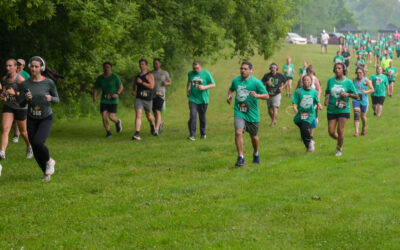The Spring Ceremonies are a time to relearn the ways of our Ancestors while also giving thanks for the arriving spring season. It’s a time to continue on with history. “History is our story now; we have a new narrative for it,” said NHBP Culture Specialist and Tribal Member Kevin Harris II.
The day began with the lighting of the Sacred Fire and a Sunrise Ceremony, followed by a delicious breakfast, which then led to the learning portion of the day, the Hide Scraping Workshop.
Along with bison hides, NHBP was able to obtain a few bison skulls.
NHBP Tribal Members Ashton Thompson and Harris had previously boiled the heads. This process took six to eight hours, which included the skinning of the hide from the head beforehand. The effort used three propane tanks.
Another cheaper and possibly more efficient way to clean a skull, which is under consideration, is the use of beetles. This particular beetle is known as the Dermestid Beetle. Their larvae are efficient scavengers that feed on dead tissue until only bone remains. Up to 5,000 may be required for a full cleaning to be achieved.
While there are many uses for the skull, it is still undetermined what NHBP will use them for.
Cultural Sustainability Lead Cusi Ballew, the Pokagon Band of Potawatomi led the Hide Scraping Workshop. Ballew learned the skill through watching and observing others. He started scraping full-time in October 2022, when he began his new position with the Pokagon Tribe.
“It’s really important people know how to do it and that we do it together. It’s a lot of work. You’re going to be sore,” said Ballew as he addressed participants.
Ballew recalled a workshop he attended where attendees were making bone needles by scraping them down on sand and cinder blocks, when his instructor told them of their Ancestors hearing them doing that and recognizing that sound of bone on sand.
“The sound of this, that scraping of the hide, our Ancestors look down and they see us doing what they recognize, what they did, and it makes them happy, and it makes them proud.”
While there are other methods that can be used, in this case, a power washer cleaned the hide, But it is important to start people out with the physical work and everyone working together.
There are many steps to scraping a hide.
For starters, the hide must be cleaned. Tribal Members gathered around to pitch in with this task. The hide was laid flat on the ground and then rinsed, scrubbed and rinsed again. This process took well over an hour as the hide was filled with dirt and bison feces, but it was essential to remove all waste and grime from the hide.
When the time came, all ages, from youth to Elders, took on the task of scraping the hide. The work does not seem difficult, but Members soon found out what Ballew was referring to when he said they would be sore, proving why it truly takes a community to perform these tasks.
“This is too much work for someone to do alone… it’s really nice that everybody is here. This is a community project. This is something that when we are done, you will have a robe that all these hands have been in, and all these people have worked on. It’s really cool,” said Ballew.
Traditionally, once the hide is cleaned, it is placed on a frame and bone tools are used to remove the remaining flesh. This allows for multiple people to work on the hide at once.
It is during these processes that there is time to reflect on all that the bison has provided.
By having an opportunity to get bison meat, Harris says, “Even when you get meat, you’re forgetting the whole process of how we got meat. So, this is our opportunity to revitalize the processing part of any animal, specifically the bison, and show our people the way to value where we get our meat from, and why we did it the way we did it and how much work it took to even get the food.”
In turn, teaching Members where the food comes from also gives meaning to the blessing and praying for the food.
This is only the first step in bison processing. Harris says the next step is havinga smoke and brand tanning workshop. If there are no errors, the hide will be made into a bison robe or rug. If there are errors, Harris hopes to make the hide into a Drum and will utilize any leftover pieces by making them into rawhide.
By renewing these traditional processes, Tribal Members are not only learning to revitalize the old ways, but they are also able to better appreciate the rewards that come with it.
“You appreciate it more when you do it yourself. It’s more sacred when you get a gift that your Community has put their hands on… The value of Culture preserves a sovereignty of who you are,” said Harris.
NHBP would like to extend a special thanks to Cusi Ballew for leading the Hide Scraping Workshop, not only teaching Tribal Members traditional ways, but for also teaching them the cultural significance of the practice.
To view the full photo gallery for this event, please click here.




0 Comments